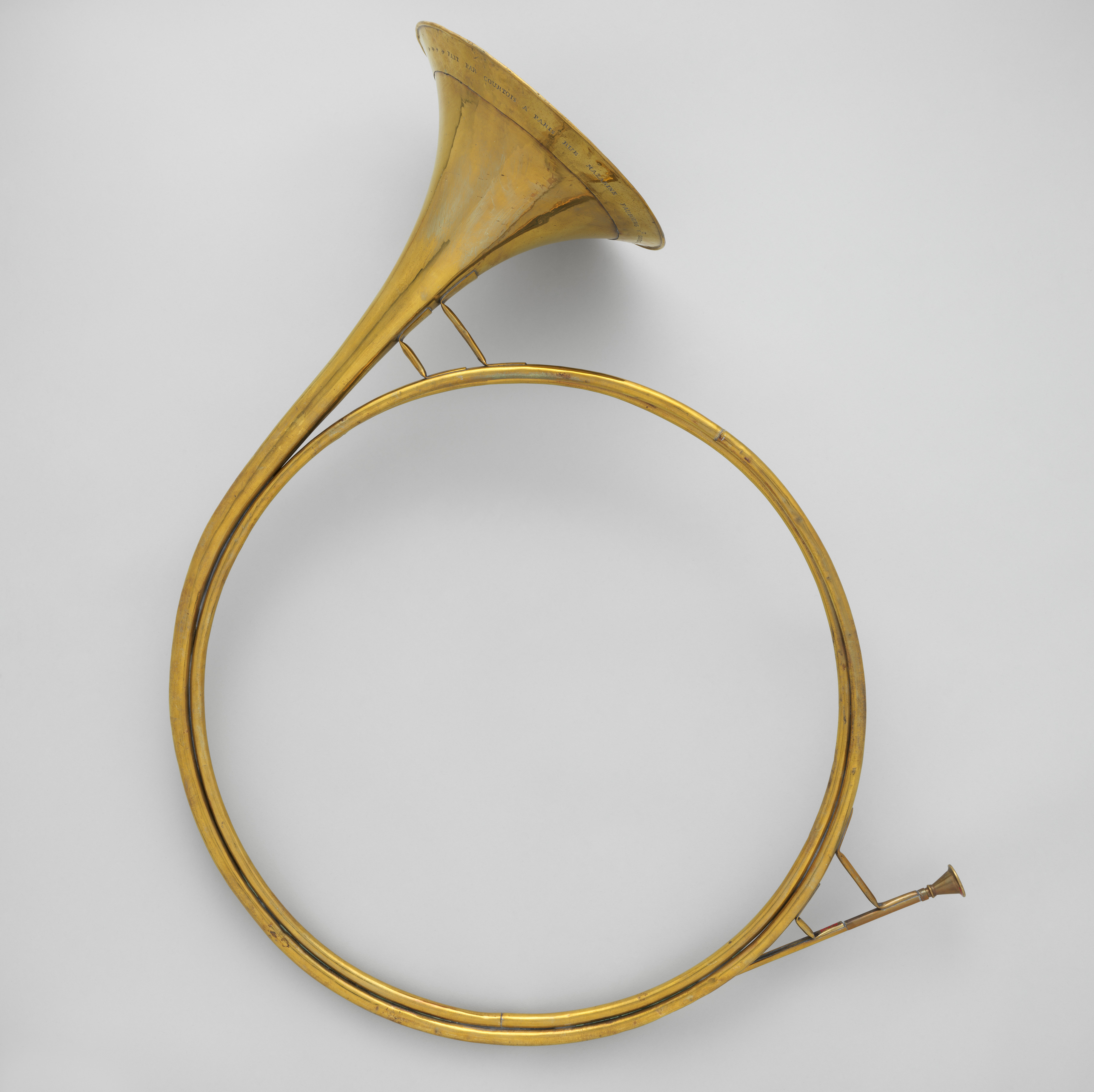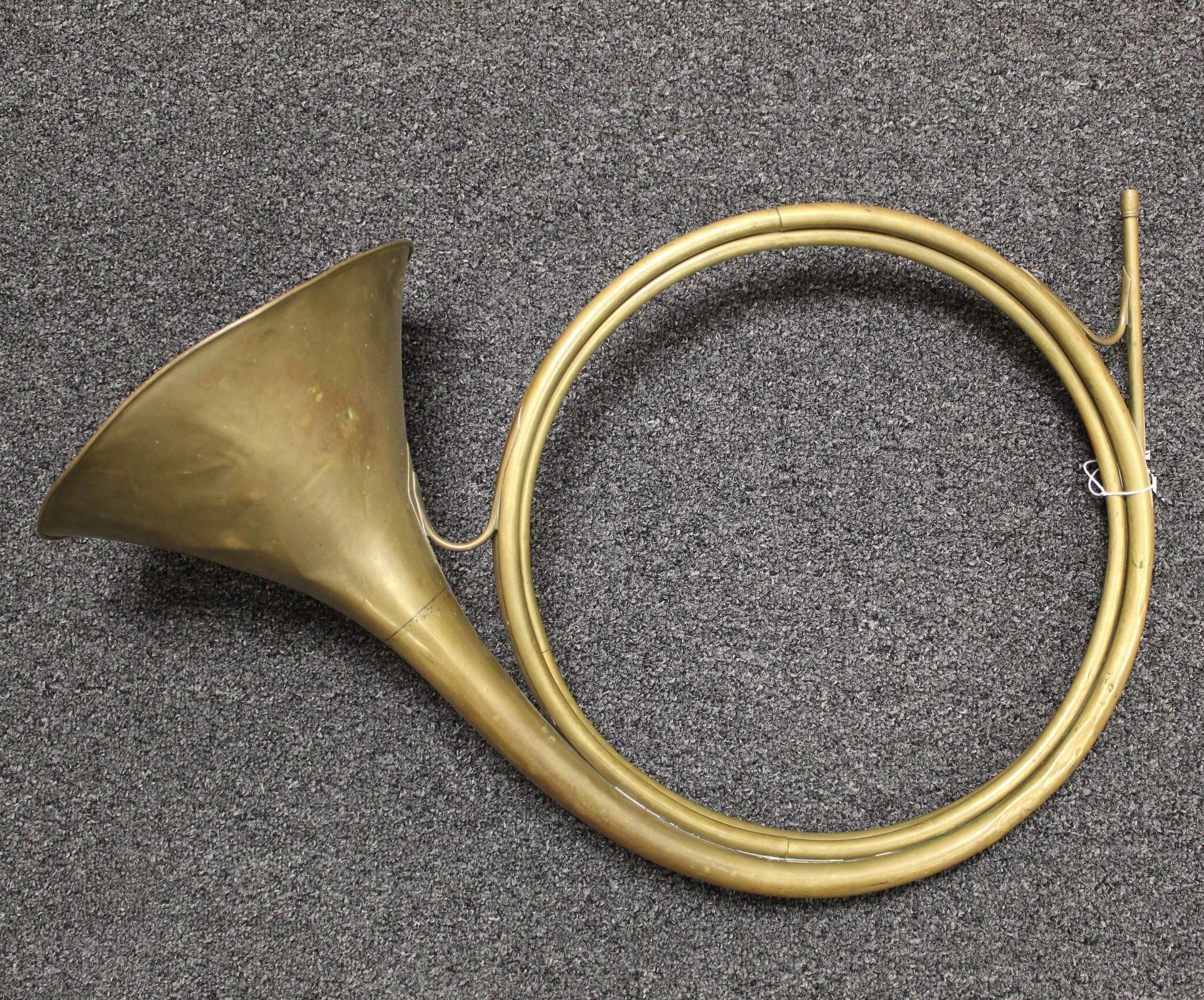Trompe de Chasse
Brass Winds
Europe
Between 1001 and 1900 AD
Video
The trompe de chasse, also known as the French hunting horn, is a brass instrument that holds a significant place in European musical and hunting traditions. Characterized by its large, coiled tubing and distinct, bright sound, it has historically been associated with hunting calls and fanfares. The instrument is typically played without valves, relying solely on the player’s embouchure and air control to produce different pitches. The trompe de chasse is visually striking, often featuring a long, intricately coiled tube with a flared bell that helps project its powerful sound across great distances.
Type of Instrument: The trompe de chasse is a brass instrument belonging to the aerophone family, which means that sound is produced by vibrating air within a resonating body. More specifically, it is a natural horn, meaning that it lacks valves and relies on the harmonic series for its notes. Like other brass instruments, it uses a mouthpiece and requires significant breath control to manipulate pitch and dynamics effectively.
History of Trompe de Chasse
The trompe de chasse has a rich and storied history that can be traced back to Europe, particularly France, in the late 17th and early 18th centuries. The instrument was developed during a time when hunting was both a practical activity and a prestigious social event among European nobility. It became an essential tool for communication during hunts, as the unique tones could signal different commands and messages over long distances.
The origins of the trompe de chasse are closely linked to the hunting traditions of France. Louis XIV’s court played a crucial role in refining its use, integrating it into both hunting and ceremonial music. By the 18th century, the instrument had gained widespread recognition, not just in France but also in neighboring countries like Belgium and Germany. Over time, it evolved from a purely functional tool to an instrument used in musical performances, particularly in orchestras and brass ensembles.
Types of Trompe de Chasse
There are several variations of the trompe de chasse, primarily distinguished by their size, tubing length, and musical range.
Trompe d’Orléans: One of the earliest forms, characterized by its shorter tubing and more compact design.
Trompe Dauphine: Slightly larger than the Orléans version, producing a fuller and more resonant sound.
Trompe de Dampierre: Named after the French composer Marc-Antoine de Dampierre, who significantly influenced the instrument’s repertoire and technique. This type became the standard for classical French hunting music.
Trompe Grand Cor: A larger variant with a broader range, used in more sophisticated musical compositions beyond hunting applications.
Traditionally, the trompe de chasse is made of brass, a material chosen for its resonance, durability, and ability to produce a bright and piercing sound. Some historical versions of the instrument were crafted using a combination of copper and brass, while modern versions often feature lightweight alloys to improve portability and ease of use. The tubing is usually coiled into a circular or oval shape, making it easier to carry and handle, especially while on horseback. The mouthpiece is typically made of brass or silver, designed to facilitate precise control over embouchure and airflow.
Characteristics
The trompe de chasse has several distinguishing characteristics that make it unique among brass instruments.
Size and Coiling: The instrument is typically coiled, often with two or three loops, which allows for easier handling while maintaining the necessary tube length for resonance.
No Valves: Unlike modern horns, the trompe de chasse does not have valves, meaning all pitches are controlled through embouchure and overblowing.
Bright, Piercing Tone: Designed for outdoor use, its sound is strong and carries well over long distances.
Limited Chromatic Capability: Since it lacks valves, it primarily plays in the natural harmonic series, making it less flexible than modern brass instruments but still expressive in its range.
Sound Production
Sound on the trompe de chasse is produced by buzzing the lips into a mouthpiece, which creates vibrations that travel through the coiled tubing, ultimately emerging as amplified sound from the flared bell. The instrument operates on the harmonic series, meaning that different notes are achieved by altering the embouchure and air pressure. Higher harmonics require tighter lip control and increased airflow, while lower notes require a looser embouchure and slower airflow.
The acoustics of the trompe de chasse are optimized for outdoor projection. The long tubing and wide bell ensure that the sound remains bright and penetrating, even across large distances. The instrument’s unique tonal qualities make it ideal for hunting calls, ceremonial fanfares, and even some orchestral applications.
Playing Methods
The trompe de chasse is played using a technique that requires precise embouchure control and breath support. The main playing methods include:
Lip Tension Control: Since there are no valves, pitch variation depends entirely on the player’s embouchure strength and flexibility.
Hand Stopping: While not as commonly used as in the French horn, some players employ hand-stopping techniques to subtly alter pitch and timbre.
Circular Breathing: Advanced players may use circular breathing to sustain long passages, especially in fanfares and ceremonial music.
Articulation Techniques: Different articulation methods, such as tonguing and slurring, are used to create distinct hunting calls and musical phrases.
Roles in Music
In addition to its role at hunts, where it serves as both an instrument of communication and music-making, the Trompe de Chasse has been featured prominently in orchestral works. Composers like Jean-Baptiste Lully incorporated it into their music as early as 1664. Its rich tone makes it suitable for outdoor performances and ensemble settings.
Although initially used for hunting, the trompe de chasse has found a place in several musical contexts. Historically, its primary function was to communicate specific messages during hunts. The instrument has been used in French military and royal ceremonies, often playing fanfares and grand processional pieces. While less common than other horns, some composers have incorporated it into symphonic works for its unique timbre. The trompe de chasse is sometimes included in traditional brass groups, particularly in France and Belgium.
Cultural Significance
The trompe de chasse holds a special place in European culture, particularly in France and Belgium. It is deeply embedded in the traditions of aristocratic hunting and has been an important symbol of nobility and heritage. The instrument is often associated with equestrian culture and remains a staple in traditional hunting ceremonies and pageants.
Beyond its practical use, the trompe de chasse has also influenced folk and classical music, inspiring compositions that celebrate its distinct sound and historical significance. In modern times, it continues to be played by enthusiasts and historical reenactment groups, preserving its legacy in contemporary musical practice. The instrument has also been recognized by organizations dedicated to historical music preservation. In some regions, playing the trompe de chasse is considered an art form, with competitions and gatherings held to celebrate its musical and cultural heritage. Its use in film scores and stage performances further underscores its timeless appeal.
Musical Repertoire
The repertoire for Trompe de Chasse includes thousands of fanfares that signal different events during a hunt:
Bien-aller: Indicates that dogs are following well.
Débuché: Signals when dogs move from one forest area to another.
Bat-l’eau: Alerts others when prey enters water.
Vue: Announces when prey is spotted.
These fanfares have become an essential part of traditional French music beyond their original context.
Comparison with Other Instruments
While similar to other brass instruments like cor naturel or cor anglais due to shared ancestry with natural horns made from animal horns or wood before evolving into metal versions, key differences exist:
| Feature | Trompe De Chasse | Cor De Chasse |
|---|---|---|
| Pitch | Typically tuned in Ré | Tuned in Mi bémol |
| Length | Approximately 4.545 meters long | Varies based on model |
| Valves | No valves | Equipped with valves |
| Musical Use | Primarily used at hunts | Used more broadly across various genres |
Despite these differences, both instruments contribute significantly to different aspects of music-making.
FAQ
What is the Trompe de Chasse?
The Trompe de Chasse is a large, coiled brass instrument used in French hunting traditions. It produces a bright, resonant sound and is typically played in outdoor settings. The instrument is popular in ceremonial and hunting-related music. Its origins date back to the 17th century.
How is the Trompe de Chasse played?
The Trompe de Chasse is played using a buzzing technique with the lips, similar to other brass instruments. The musician controls pitch and dynamics by adjusting embouchure and breath pressure. It does not have valves, so notes are produced through natural harmonics. Players often perform fanfares and hunting calls.
What is the historical significance of the Trompe de Chasse?
The Trompe de Chasse was originally used for communication during hunting in French aristocratic traditions. Over time, it became an important musical instrument in formal hunting societies and ceremonies. Today, it is still played in ensembles dedicated to preserving its cultural heritage. The instrument remains a symbol of French hunting traditions.
 Links
Links
References
Other Instrument
Categories



















